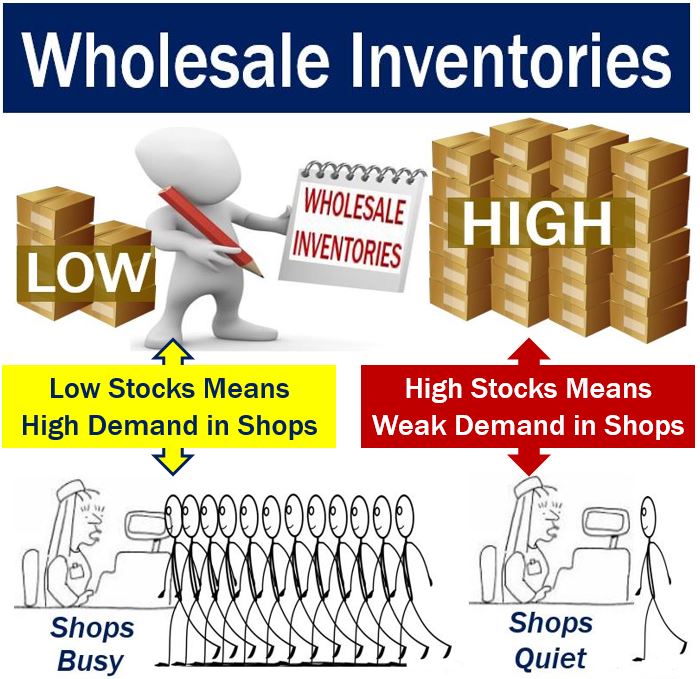The term wholesale inventories refers to reports that some statistical agencies issue which track changes in the sales and inventory levels of wholesalers. In the United States, for example this information is published monthly by the US Census Bureau.
Wholesale inventories is the stock level of unsold inventories that wholesalers hold.
The wholesale inventories figure is more significant than the sales figure, because high or low inventory levels reflect how strong or weak retail demand is, which determines whether manufacturing production increases or declines. Wholesalers’ stock levels tell you whether GDP (gross domestic product) is going to expand, contract, or stay the same.
The US Census Bureau, however, reports monthly on figures that are already two months old, which to makes it harder to produce meaningful forecasts.
 When retailers (shops) experience weak demand, wholesaler inventories rise, but when demand in shops increases, stock levels in wholesalers’ warehouses declines.
When retailers (shops) experience weak demand, wholesaler inventories rise, but when demand in shops increases, stock levels in wholesalers’ warehouses declines.
Business.Dictionary.com has the following explanation for wholesale inventories:
“Amount of unsold inventory still in the possession of the wholesaler. If wholesale inventories start to become elevated, that typically means that retailers are purchasing less because demand for the products has decreased.”
“Analysts look to wholesale inventory figures to see how the consumer market is performing.”
What do wholesale inventories tell us?
Wholesalers are intermediaries – they are positioned in the economy between manufacturers or importers, and retailers. The wholesaler sells directly to the retailer, who ideally strives to act in accordance with consumer demand.
If wholesalers have high inventory levels – if stocks are high – it means that unsold goods are accumulating, which suggests that retailers are facing weak consumer demand, i.e. shoppers are buying less.
On the other hand, if wholesalers’ stock levels are low, it means that retailers are facing strong demand, i.e. shoppers are buying more.
Regarding wholesalers’ inventory, FX Words writes:
“Because Wholesale Inventories reflect the demand retailers have for their manufacturers’ wares, the report offers an early indication of the potential strength of consumer spending. Wholesale Inventories are reported in headlines as a percent change from the previous month.”
 The US Census Bureau publishes its Inventories/Sales Ratios of Merchant Wholesalers every month. According to Lexicon.FT.com, inventory-to-sales ratio is: “The amount of stock that a company has compared with the amount of goods that they have sold in a particular period of time.” (Image: adapted from census.gov)
The US Census Bureau publishes its Inventories/Sales Ratios of Merchant Wholesalers every month. According to Lexicon.FT.com, inventory-to-sales ratio is: “The amount of stock that a company has compared with the amount of goods that they have sold in a particular period of time.” (Image: adapted from census.gov)
Wholesale inventories in USA – an example
In June 2017, the US Census Bureau published data on wholesale inventories for the month of April 2017.
The bulletin informed that total inventories of merchant wholesalers were $591.0 billion, which was -0.5% down from the revised March 2017 level and +1.6% up compared to April 2016.
This suggests that consumer demand had strengthened in April 2017 compared to the previous month, but had weakened compared to the same month in 2016.
